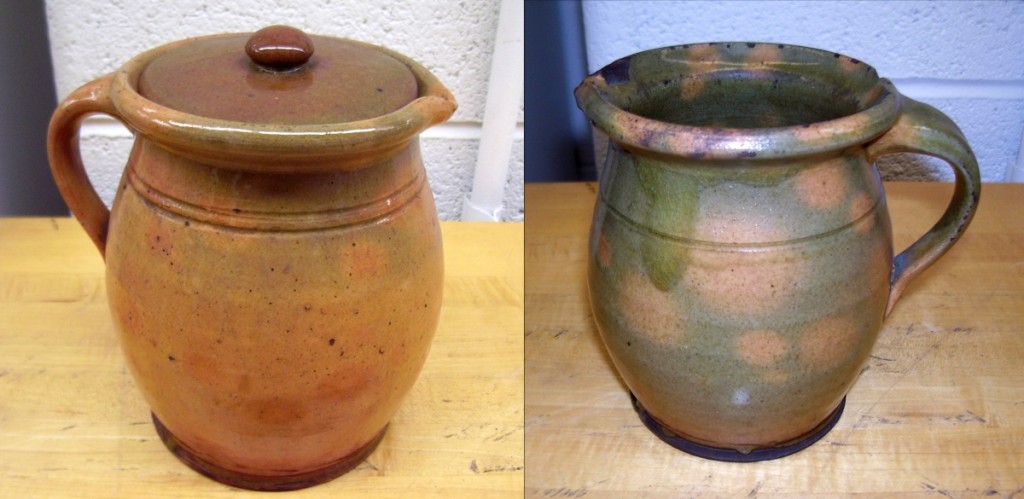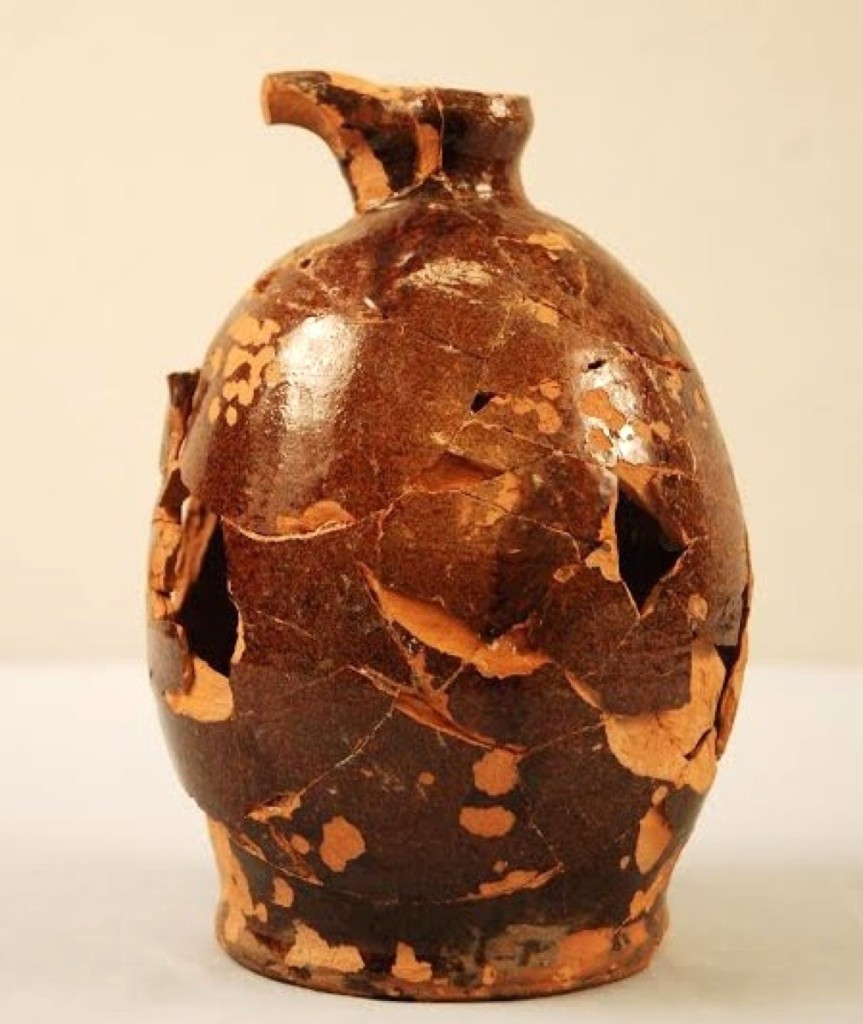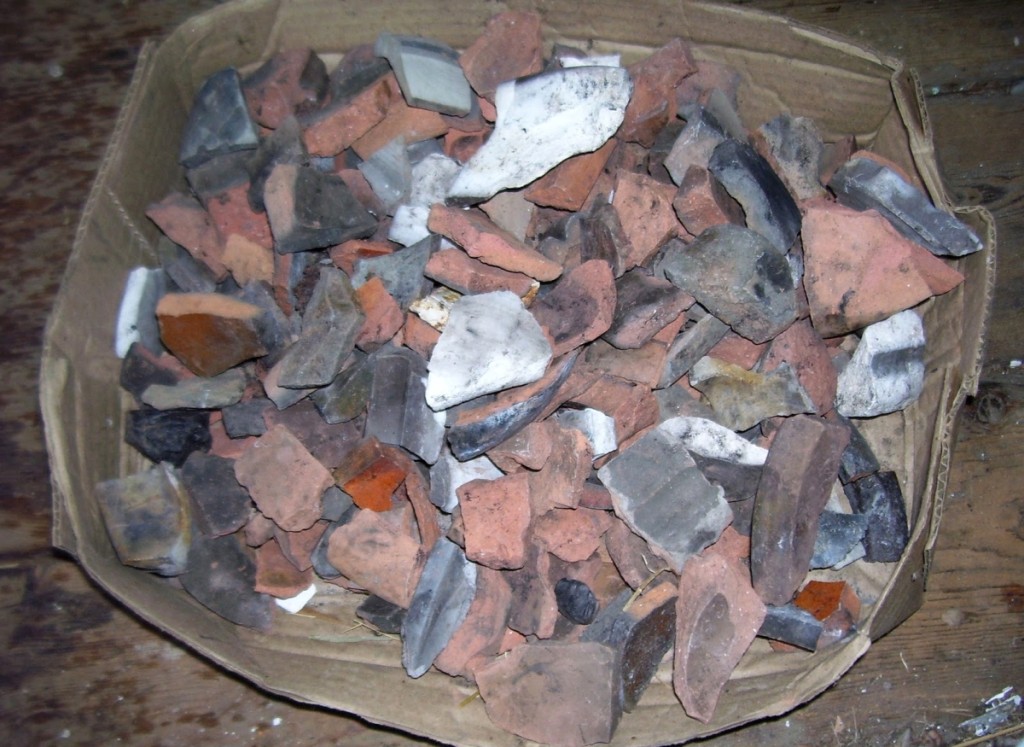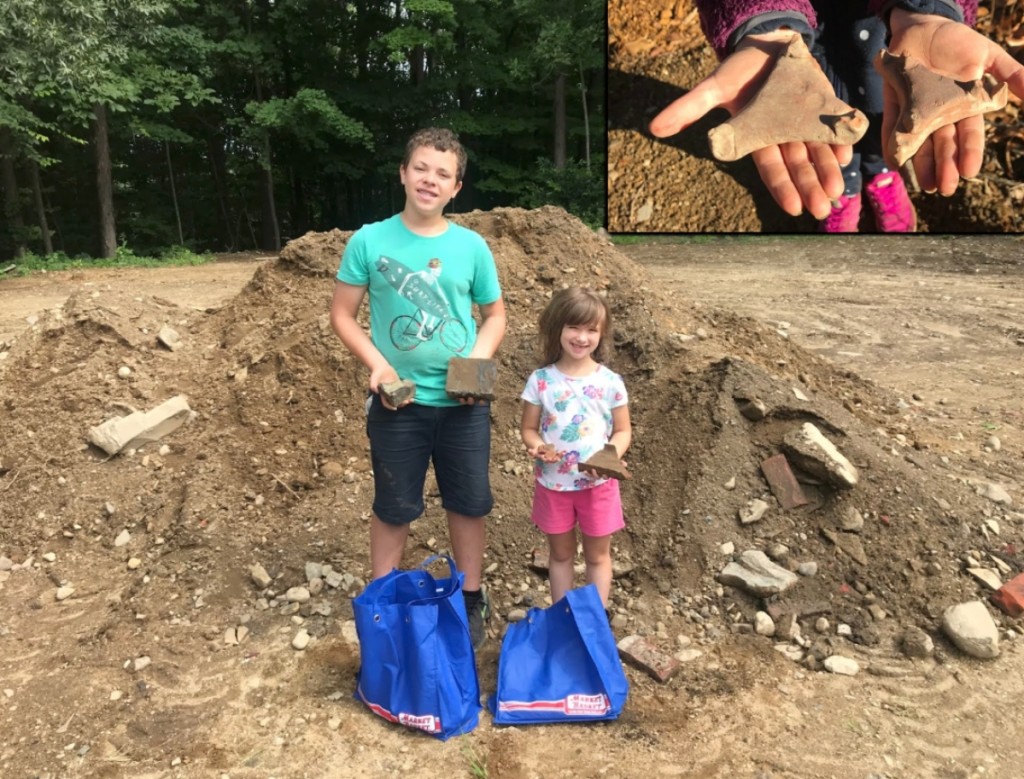
Pitchers, attributed to the James Chase Pottery, Merrimacport, Mass, circa 1820-49. These forms could be mistaken for production from the William Pecker Pottery today. Courtesy the National Museum of American History at the Smithsonian Institute.
By Justin W. Thomas
NEWBURYPORT, MASS. – Settled in 1635, the city of Newburyport was originally part of the Newberry Plantation (now Newbury), which was inhabited by English colonists from Wiltshire, England in the northeastern part of coastal Massachusetts. Waterways were certainly a major draw for these early settlers, with the area being surrounded by the Merrimack River and the Parker River. The port city quickly became prosperous as a popular fishing and trading center, and it turned to agricultural needs.
With this success came a growth in population, and hundreds of first period and Georgian-style homes were built in the area. A demand quickly grew for artisans, laborers, imported goods and household utilitarian wares.
Newburyport was formed in 1764, when the General Court of Massachusetts passed an act for erecting part of the town of Newbury into a new town by the name of Newburyport. West Newbury set off into its own town in 1819, forming the three communities that make up this area today. While Newbury and West Newbury remain towns, Newburyport was incorporated as a city in 1851.
The Bayley Potteries
Almost 90 years after Newbury was settled, the first known local pottery was established about 1723 by Joseph Bayley (1701-1761), a direct descendent of James Bayley (1612-1677) who was among the first group of settlers in Rowley, Mass., in 1639. It has not been identified where Bayley was taught the pottery craft, but he may have learned about it from another Colonial Essex County, Mass., potter or possibly in Charlestown, Mass., which is where the earliest red earthenware was manufactured in New England in the 1600s.
Joseph and his wife left Rowley in 1735, when they were removed from the church, and relocated with their four children to Newbury (Newburyport). Joseph continued to produce red earthenware in Newbury until the early 1760s, when his son Daniel (1729-1792) became owner of the business. Daniel must have learned the pottery business from his father, but there is also evidence to suggest he operated a pottery in Gloucester, Mass., in the 1750s, when he married Elizabeth Dennen (d 1765) from Gloucester on April 21, 1750. The couple spent the next decade in Gloucester, where they had three children, but only two survived. Elizabeth Bayley was born April 2, 1753, and Daniel Bayley Jr (1755-1799) was born July 15, 1755 eventually becoming a potter himself.

Jug attributed to the Bayley Pottery recovered at the site of Jonathan Lowder’s Trading Post in Veazie, Maine, within a circa 1775-79 archaeological context. Courtesy the University of Maine.
By 1763, Daniel had relocated to High Street next to St Paul’s Church in Newbury, which became Newburyport the following year. This is where he built the pottery business that he is most known for today. Sadly, his wife died two years later, and he quickly married a woman named Sarah Stone (d 1792), a widow herself and mother to three children. Soon after, they had four more kids, two of whom also entered the pottery industry, William Bayley (1766-1799) born May 9, 1766 and Nathaniel Bayley (1771-1849) born June 16, 1771.
The Bayley Pottery turned into a family enterprise, but some of the Bayley kids also worked for Ebenezer Morrison (1741-1803), who established a red earthenware company next to Old Hill Cemetery in Newburyport. As a result, it is believed that the forms were similar at both businesses. Morrison continued to produce pottery into the early Nineteenth Century, while the Bayley Pottery declined with Daniel Bayley’s death in 1792, and production ceased altogether when Daniel Bayley Jr and William Bayley died in 1799.
Daniel Bayley also employed potters who were not immediate relatives, such as John Thomas (1754-1843) in the 1770s-80s, who was a native of Gloucester and later went on to establish the industry in North Yarmouth (known as Yarmouth after 1849), Maine about 1791.
The wares made at the Bayley Pottery were not only intended for the local marketplace. Based on archaeology, pottery was distributed throughout New England, with examples found in Salem, Mass., Historic Westbrook, Maine, Portsmouth, N.H., possibly Wellfleet, Mass., on Cape Cod, as well as the site of Colonial trading posts in Veazie, Maine and Saint John, New Brunswick.
Archaeological evidence recovered by Massachusetts author, Lura Woodside Watkins (1897-1982) at the site of the pottery was published in 1950 in Early New England Potters and Their Wares. A Route 1 underpass was constructed through the Bayley site in 1934, revealing an excellent collection of artifacts now owned by the National Museum of American History at the Smithsonian Institute in Washington, DC. The evidence shows an emphasis devoted to the production of slipware, a style of decoration applied with liquid kaolin clay. The known forms decorated in slip include chamber pots, plates, pans and porringers, while other styles combine various forms of bowls, jugs, mugs and flowerpots. The glazes range from dark colors like black and brown to more colorful glazes such as green. The extent of the colors and slip applied at the Bayley Pottery in the 1700s was among the more decorative wares manufactured anywhere in New England during this period.
The Merrimacport Potteries
The landscape of the New England pottery industry changed drastically with the American Revolution. The industry in Charlestown, Mass., had been a centralized production center in New England in the Seventeenth Century through 1775. Wares were shipped all over the region from Connecticut to Cape Cod, Martha’s Vineyard, all over the Boston area, Portsmouth, N.H., Berwick, Maine, throughout coastal Maine (then part of Massachusetts) and even into parts of Canada, like the Fortress of Louisbourg on Cape Breton Island in Nova Scotia. However, this industry was decimated and sacrificed in America’s fight for independence at the Battle of Bunker Hill on June 17, 1775, during the siege of Boston in the early stages of the American Revolution.
Some of the Charlestown potters who were around for the American Revolution relocated elsewhere in New England, such as Benjamin Bodge (1747-1822) who moved to Merrimacport (then South Amesbury), Mass., about 1775, a small village located along the Merrimack River just upriver from Amesbury and Newburyport. Bodge married Susanna Pecker in Haverhill on September 27, 1770, but the extent of his pottery production in the area is unknown today.

Some of the artifacts collected in the 1990s at the site of the Merrimac Pottery Company in Newburyport, Mass. Some of the objects are impressed “Merrimac Pottery Company.” The pottery used two types of earthenware clays, one with a white clay body and the other with a red clay body. Courtesy the Museum of Old Newbury.
Susanna’s brother, William Pecker (1758-1820) also born in Haverhill, and an Essex County trained potter is found in Merrimacport in 1784. It seems that Pecker remained employed with his brother-in-law until the early 1790s, when he established his own pottery. Bodge’s role might have also changed, and he may have now helped Pecker with his business.
The Pecker Pottery is largely known today for the lead glazed red earthenware that was produced during the circa 1791-1820 period. The most common surviving glaze is an orange or reddish lead glaze with brush strokes of manganese. The skill found at this business is some of the most refined wares made anywhere in New England. Known forms include jugs, pitchers, pots, bowls, flasks, pans, chamber pots, porringers and flowerpots. There is also some speculation that Pecker or Bodge possibly produced some slipware, but that has not been proven in archaeology.
Archaeology has shown that the wares made at the Pecker Pottery were sold throughout the Merrimack River region, with Newburyport serving as a major marketplace. Although, wares have also been found throughout New Hampshire and southern Maine.
An aspect of the Pecker Pottery that is somewhat unknown is the fact that dozens of glaze colors have been recovered at the site of the pottery. The colors range from black to green to vibrant multicolored glazes.
But Pecker was also a stoneware potter. In fact, it was not identified in publication until the 2004 issue of Ceramics in America that there are known pieces of marked Pecker stoneware in existence. Archaeologist John Kile wrote that article based on a 2-gallon handled crock marked “Wm Pecker” found at a Kentucky flea market. The crock was decorated on one side with a stamped bird perched on a branch and the other with a stamped flower. Since that article was published, somewhere around one to two dozen (maybe more) pieces of Pecker stoneware have been identified, some of which have been previously attributed to other locations. It has also been discovered that Pecker applied a fish stamp, as well as cobalt used for an aesthetic blue decoration.

Justin Thomas’ niece, Alexis, and nephew, Jason, holding kiln furniture and kiln bricks recovered at the site of Phineas Chase’s circa 1863-90s business in Merrimacport, Mass. Inset Photo: More kiln furniture recovered at the site of the Phineas Chase Pottery.
Nonetheless, Pecker apparently taught his nephew, James Chase (1778-1849) the potter’s craft; James was born in 1779 to Pecker’s sister, Hannah, who had married Edmund Chase, and by 1816 began making his own pottery in Merrimacport. He saw how Pecker ran the pottery business; he witnessed Pecker’s secrets on the potter’s wheel; he knew his glaze recipes; and he even understood Pecker’s wonderful eye for proportion within a perfectly balanced form. The Charlestown connection also continued with Chase, having married Olive Lucas of Charlestown. The couple reportedly met in Andover, Mass. We do not know for sure why he was in Andover, but he may have been attempting to establish a business, moving back to Merrimacport in 1816.
Chase took ownership of all red earthenware production in Merrimacport in 1820, when William Pecker died from a tragic kiln accident. He owned a house next door to Pecker, and about the time of Pecker’s death, a kiln was built on his property. Chase continued to run the business in the same way as his mentor. In the latter years of the 1830s-40s, James’ son, Phineas Chase (1820-1911) worked alongside his father, learning the family business.
The forms made at James Chase’s business are just as well made as the wares produced at the Pecker Pottery, and can be confused for some of Pecker’s production today. The Smithsonian Institute owns the best museum collection of wares made during this period in Merrimacport, acquired from the collection of Lura Woodside Watkins.
After James’ death in 1849, the business was taken over by Phineas, and continued to operate at the same location in Merrimacport until 1863, when he sold the land to the South Amesbury Wharf Company, and moved the business to his property about one-quarter mile from the Merrimack River. The forms evolved with Phineas in the 1870s-80s, when he focused on the production of flowerpots and vases, some painted and others decorated in a variety of glazes. He also manufactured traditional utilitarian forms like pie plates, custard cups, pans and pots.
The story of the Bodge, Pecker and Chase potteries ended in the 1890s, when Phineas ceased production altogether in his 70s. His obituary reading in 1911, “Mr Chase was a man of sterling honesty and marked integrity and had the respect and confidence of the community.”
Thomas Nickerson’s Merrimac Pottery Company
Thomas Nickerson established the Merrimac Ceramic Company in Newburyport in 1897, largely manufacturing floral and garden wares. Nickerson was an English-trained potter, who had relocated from Portland, Maine. The pottery was given its name after the Merrimack River. A condominium development now resides in place of where the pottery business once stood. When the condominiums were built in the 1990s, former curator of the Museum of Old Newbury, Jay Williamson and Chris Snow recovered hundreds of artifacts from the pottery, showing that Nickerson was utilizing multiple types of earthenware clays.
Nickerson’s products in the first four years were sometimes marked with a paper label, “Merrimac Ceramic Company” with a picture of a sturgeon, a fish native to the Merrimack River.
In 1902, Nickerson changed the name of the business to the Merrimac Pottery Company. Rather than a paper label, an impressed mark was incorporated on the base of many products that read, “Merrimac” with an image of a sturgeon. The company made colorful art pottery, exquisite garden pottery and reproduction Roman pottery taken from actual 2,000-year-old ancient objects owned by the Museum of Fine Arts, Boston. This new direction allowed Nickerson to demonstrate his true skill as a potter to a national marketplace.
Nickerson’s glazes are often breathtaking with a variety of vibrant colors that adorned accomplished forms, which are represented in major art museums across the country, such as the Museum of Fine Arts, Boston; the Metropolitan Museum of Art; and the Smithsonian. The wide variety of glaze colors include variations of green, yellow, rose, blue and orange. Nickerson was also recognized for his matte, luster and crackle finishes.
Unfortunately, only a few years after the company was rebranded, the Merrimac Pottery Company burned to the ground in 1908, never to be rebuilt, and ending the longstanding tradition of utilitarian and household pottery production along the Merrimack River in the greater Newburyport area.












